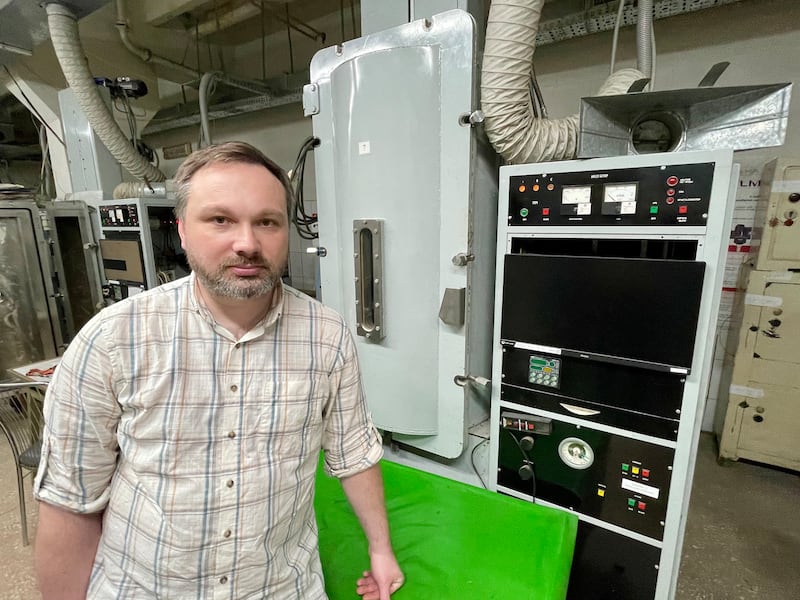Surprises often await behind boarded-up windows in Kharkiv, a bomb-scarred Ukrainian city near the Russian border that suffers almost daily air strikes.
A patched-up and sandbagged facade may hide a stylish cafe, pop-up art gallery, film screening or concert, or even scientists who have continued to supply vital components to the world’s biggest physics experiment through almost 2½ years of war.
Ukrainian scientists have worked for decades with the European Organisation for Nuclear Research, better known as Cern, which is most famous for smashing particles together in the Large Hadron Collider 100m below the Swiss-French border.
The collider fires streams of particles near light speed through a 27km loop of super-cooled magnets. This causes collisions that mimic the moments after the Big Bang and release other subatomic particles that may help explain the nature of matter and antimatter, gravity, black holes, and other puzzling features of the universe.
READ MORE
Exotic particles such as the Higgs boson, which was discovered at the collider in 2012, exist for fractions of a nanosecond and can only be spotted by ultra-sensitive detectors using the purest crystals and other materials that scintillate under radiation, emitting light that can be analysed to identify specific particles.
In Kharkiv’s Institute for Single Crystals (ISC), Oleksandr Sorokin holds a clear commemorative cube — etched with an artist’s impression of the experiment that uncovered the long-sought Higgs boson — that recognises its role in the Nobel Prize-winning discovery.
“There have been several explosions near the institute. The roof and windows have been damaged but we’ve been lucky so far,” says Sorokin, deputy director of science at the ISC’s Institute for Scintillation Materials, of the Russian invasion that began in February 2022.
“On one occasion, cluster bombs landed on either side of the institute, but it was not directly hit ... No one knows what could happen in the next five minutes. All we can do is hope for the best and cross our fingers.”
They have also shown that they can keep working, on technology and materials with applications spanning particle accelerators, medical and security scanners, pharmaceuticals, and industries that use man-made sapphires and other crystals.
“The most important thing is to show all our partners that, despite everything that is happening, we can meet our obligations. We have finished and delivered all materials that were ordered,” says Sorokin. “There could have been a force majeure situation in 2022 but then our customers would not have placed orders in the future. And we need them.”
Russian forces bombed Kharkiv on the first morning of the all-out invasion and soon reached its ring road, from where they shelled the centre of Ukraine’s second city. About a million residents fled, while some of those who stayed took refuge in two ISC buildings.
“We have a shelter that is 30m underground and more than 200 local people stayed there for about six months in 2022. Four of them were taken away by the police for spying, for giving information to the Russians,” says Sorokin.

Dozens of staff members gathered in another ISC building, where they lived with their families and pets while continuing to work and maintain expensive equipment.
“We spent a few months living underground here at the institute,” says Yaroslav Gerasimov, deputy head of the crystal growth technology department, whose apartment is in the severely damaged Saltivka area of Kharkiv.
“My two daughters were here with a lot of other kids. We were working, eating, sleeping, washing here ... There were beds everywhere,” he adds.
“We had to keep all this equipment in working condition. Even at the beginning of the full-scale war we didn’t stop growing crystals. We have delivered materials to Cern every month of the full-scale war.”
Scientists took on unfamiliar jobs to keep things going: Sorokin cycled through the emptying city delivering documents like a courier; Mykola Sibiliev, now head of the measurements department, took charge of provisions at one of the shelters; other staff drove colleagues into work under shelling because public transport had stopped, and helped move vital crystal-making equipment from a building badly damaged by shelling.
It is all part of an effort to safeguard the scientific heritage of Kharkiv — a powerhouse of research and development since Soviet times that is home to dozens of scientific institutes and universities.
“We want to make and distribute our products but keep our technologies,” says Sorokin, identifying China as a big rival.
“Even though they have their own raw materials and very large state support, their technology is still not as good as ours. But if they got our technologies, they would push us out of the market,” he adds.
“Kharkiv has a strong history in academic work and scientific research. We are trying to keep this going.”














